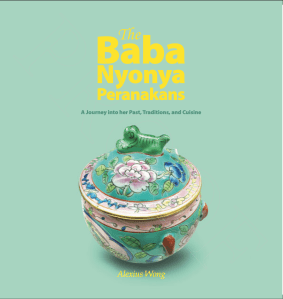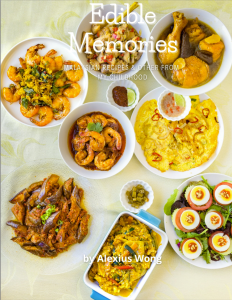
In the West, they enjoy Smores, a sandwich of sweet crackers with a gooey filling of melted marshmallow and chocolate. For the Peranakans, we enjoy another wonderful molten sandwich concoction after the Chinese New Year to finish off the Kueh Bakul that was prepared a few weeks before as an offering for a religious day.
Shortly after the Winter Solstice, a ceremony called the Kitchen God Send-Off (Sembahyang Datok Dapur) is held in which the Kitchen God (Hokkien: Thé Chu Kong) goes on his annual trip to heaven to report the household year’s happenings to the heavenly realm. One week before the Lunar New Year (celebrated around the end of January or in February), offerings of three cups of tea, a pair of lighted candles, kueh bakul, and prayers are made along with the sound of firecrackers to send him off to the heavens, hopefully with little news—or preferably no—news to report (photo).
In this recipe, we can see how the Peranakans adapted a Chinese ingredient by pairing it with elements from their new Southeast Asian homeland. Kueh bakul in Baba Melayu, the Peranakan vernacular, means “cake in a basket” since banana leaves are shaped into molds for the paste. Known as neen koh in Cantonese and ti kueh in Hokkien, this cake is made just before the Lunar New Year celebrations, thus its Chinese name translates to “New Year cake.”
The Peranakans took this Chinese sticky sweet concoction and paired it with tubers common to Southeast Asia, resulting in a dessert that is totally different in character and texture. Make sure not to cut the root slices too thick, or else the “sandwich” will be too large.
You can find this sweet paste in most Asian stores around the Lunar New Year celebration. However, look for those made in Malaysia since they are firmer and sweeter than the softer versions made in China.
I prefer eating these sweet treats piping hot or just after they have cooled down for a minute while the soft, sticky, toffee-like kueh bakul filling coats the starchy root slices like caramel sauce. The crispy batter coating makes the perfect textural contrast to the melting kueh bakul and the firmer yam and taro slices. Growing up in Malaysia, I couldn’t wait for this sweet paste to be fried or steamed with fresh coconut, served right after the Chinese New Year when these treats were usually enjoyed. If the treats had not been cooked at home, my parents would seek out a roadside vendor selling them along with another treat, fried battered banana—both were heavenly snacks for us children. If you cannot find yams, you can use sweet potatoes.
Recipe from The Baba Nyonya Peranakans book
Serves 4 to 6
Preparation time: 1 hour (with pre-refrigerated Kueh Bakul)
200 grams (7 ounces) kueh bakul, cut into ½-centimeter (¼-inch-thick) half rounds
200 grams (7 ounces) yam, peeled and cut into ½-centimeter (¼-inch-thick) half rounds
200 grams (7 ounces) taro, peeled and cut into ½-centimeter (¼-inch-thick) half rounds
200 grams (7 ounces) rice flour
½ teaspoon salt
2 cups vegetable oil
- Refrigerate the kueh bakul for at least 2 hours before cutting it so it hardens slightly. Cut pieces that are slightly smaller than the width of the yam and taro slices. After cutting, sandwich the kueh bakul pieces with yam on one side and taro on the other. The root slices have to cover the slice of kueh bakul, but the sides do not have to be perfectly aligned.
- In a bowl, mix enough water into the rice flour to make a very thick batter, like condensed milk. Add the salt and mix well.
- Heat a saucepan with the oil on medium-high heat until hot. Using a pair of wooden chopsticks, dip the sandwich into the batter and coat it well. Gently lower the sandwich into the hot oil, and let it fry without moving it around, even if it sticks to the bottom—it will unstick after a minute. Fry until golden brown and a bit of the filling is oozing out. The yam and taro slices should be completely cooked.
- Remove and drain on paper towels. Serve hot or room temperature.


The hardcopy and e-book of The Baba Nyonya Peranakans book (1st image) and Edible Memories e-cookbook (2nd image) are available – more information on the Homepage.

Remember fondly how much I liked this version and also the steamed one with fresh coconut gratings with a pinch of salt made by my mother.
LikeLike
Yes, this cooking method and also the steamed coconut version as you indicated are popular and tasty ways to eat them.
LikeLike